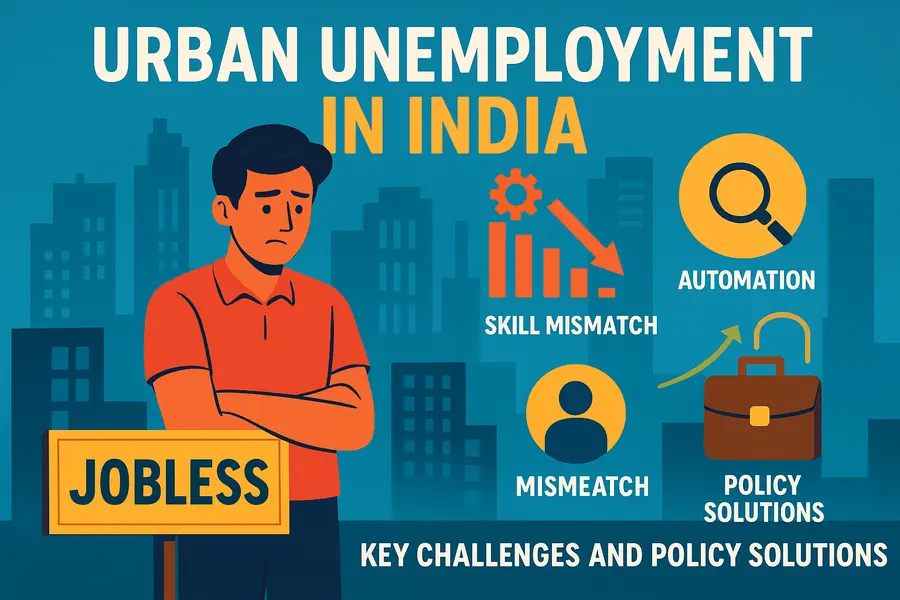Urban India is buzzing with opportunity, yet unemployment remains one of its toughest realities.
From fresh graduates struggling to land their first job to skilled workers facing shrinking demand, the urban labor market reflects both promise and pressure. Why does this gap between talent and opportunity persist, and what can be done to bridge it?
In this article, we’ll unpack the key challenges driving urban unemployment—ranging from rapid migration and automation to mismatched skills—and explore practical policy solutions shaping the future of work.
Whether you’re a student, policymaker, or curious reader, this guide will help you understand the roots of the problem and the strategies India needs to create inclusive, sustainable urban growth.

Urban Unemployment in India: Key Challenges and Policy Solutions Explained
In 2025, India’s cities are buzzing with startups, new tech hubs, and smart infrastructure — yet unemployment continues to rise.
According to recent data, urban joblessness has touched worrying levels, especially among educated youth. This paradox of “growth without jobs” shows how rapid urbanization has not automatically translated into stable employment.
As millions migrate to cities in search of better opportunities, they often end up in informal or temporary work.
Despite impressive economic progress, India’s urban labor market faces deep-rooted structural, educational, and policy issues that must be addressed.
Understanding and fixing these challenges is essential for building cities that truly deliver on the promise of growth and inclusive employment.
Let’s explore the key challenges driving urban unemployment in India — from skill mismatches and automation to policy gaps and economic shifts. Look at how government initiatives and innovative solutions can bridge the widening job gap.
Understanding Urban Unemployment in India
Urban unemployment in India refers to the situation where people living in cities and towns are willing and able to work but cannot find suitable jobs. It includes several forms — disguised unemployment, where more people work than needed; educated unemployment, where skilled graduates cannot find jobs matching their qualifications; and seasonal unemployment, where work opportunities fluctuate across months.
As of 2025, India’s urban unemployment rate has remained high, hovering around 8–9%, according to data from CMIE and NSSO.
While cities like Delhi, Mumbai, and Bengaluru continue to expand economically, job creation hasn’t kept pace.
The youth segment (ages 20–29) faces the most pressure, with unemployment rates often double the national average.
Women’s participation in the urban workforce also remains low due to safety concerns, lack of flexible jobs, and social barriers.
There are also strong regional differences — metros attract more educated job seekers, while Tier-2 and Tier-3 cities struggle with limited industry presence.
Among sectors, manufacturing has slowed down due to automation and weak demand. The IT and startup ecosystem faces layoffs and hiring freezes amid global market uncertainties.
The gig economy, once seen as a solution, has become unstable, offering irregular income and limited benefits.
The construction sector, a major urban employer, continues to stagnate due to reduced investments and project delays.
Understanding these patterns is crucial for addressing India’s urban job crisis. The problem is not just about the lack of jobs, but about the quality, stability, and inclusiveness of employment opportunities in fast-growing cities.
Key Causes Behind Urban Unemployment in India
Urban unemployment in India is not caused by a single factor — it’s the result of multiple interconnected challenges. Here are the eight major causes that define the issue in 2025:
Jobless Economic Growth: India’s GDP has grown steadily, but this growth hasn’t translated into enough jobs. Many industries are becoming more capital-intensive, meaning they produce more goods and services with fewer workers. As a result, economic progress benefits production numbers, not employment.
Automation and AI Displacement: With rapid digitalization, machines and algorithms are taking over tasks once done by humans, especially in manufacturing, IT, and customer service. Mid-level employees are most affected, leading to job losses or fewer entry-level openings.
Skill Mismatch: There’s a growing gap between what educational institutions teach and what industries actually need. Many graduates lack practical, job-ready skills, which leads to educated unemployment in cities.
Rural-to-Urban Migration: Millions migrate to cities every year seeking better opportunities. However, the urban job market cannot absorb this influx, causing an oversupply of labor. Many end up in informal jobs or underemployment.
Informalization of Work: A large share of urban workers are employed in gig, freelance, or contract roles without job security, fixed income, or social protection. While flexible, these jobs lack long-term stability.
Policy Inefficiencies: Employment schemes often focus on rural areas, leaving cities with limited direct support. Urban employment programs remain fragmented and poorly executed.
Post-COVID Structural Shifts: The pandemic permanently altered industries such as retail, tourism, and hospitality. Many small urban businesses never recovered, reducing job availability.
Urban Cost of Living Pressure: High rents and expenses make it difficult for low-income job seekers to survive in cities, pushing them into informal or precarious work.
These factors create a complex web of challenges that demand holistic, data-driven, and inclusive policy responses.
Socio-Economic Impact of Urban Unemployment
Urban unemployment in India goes beyond the lack of jobs — it deeply affects the social and economic fabric of cities. The following eight points explain its major impacts:
Poverty and Inequality: As urban living costs rise, stagnant or unstable incomes push many families into poverty. The gap between the rich and poor widens, creating visible inequality in housing, education, and access to healthcare.
Declining Living Standards: Unemployed individuals often struggle to afford rent, food, and transportation in cities. This forces them into smaller homes or shared accommodations, lowering overall living quality and access to basic services.
Mental Health and Social Alienation: Long periods of joblessness lead to stress, anxiety, and loss of self-worth, especially among young people. Many feel disconnected from society, contributing to rising mental health issues in urban India.
Youth Frustration and Delayed Milestones: With fewer job opportunities, young adults delay marriage, home ownership, and family planning. This not only affects individual aspirations but also slows broader social progress.
Migration Reversal Trends: Many workers, unable to find stable urban jobs, are returning to smaller towns or rural areas. Others depend on gig or freelance work for survival, even if it offers no long-term security.
Rise of Informal Settlements: Job scarcity and low income contribute to the growth of urban slums, where basic amenities are lacking. This further strains city infrastructure and deepens urban inequality.
Political and Social Ramifications: Persistent unemployment can fuel anger, protests, and populist political movements. Disillusioned citizens may lose trust in institutions, weakening democratic participation.
Economic Slowdown Cycle: High unemployment reduces consumer spending, which slows business growth and discourages investments—creating a vicious cycle of weak demand and fewer jobs.
Overall, urban unemployment doesn’t just harm individuals; it destabilizes families, communities, and the economy. Tackling it is essential for building fair, peaceful, and resilient Indian cities.
Government Responses and Existing Schemes
To tackle urban unemployment, the Indian government has launched several programs between 2020 and 2025 aimed at boosting skills, entrepreneurship, and job creation.
The Skill India 2.0 program focuses on upgrading vocational training and linking it more closely with industry needs.
Startup India and Digital India job drives have encouraged innovation and self-employment, especially among young entrepreneurs and tech professionals.
Schemes like PM-DAKSH (Pradhan Mantri Dakshta Aur Kushalta Sampann Hitgrahi Yojana) aim to provide skill development for marginalized groups, while the PM-Vishwakarma Yojana supports artisans and traditional craftspeople through training, financial aid, and digital integration.
The Production Linked Incentive (PLI) scheme has stimulated manufacturing and electronics sectors, generating indirect employment in urban areas.
Several states have also launched their own initiatives. For instance, Delhi’s Rozgar Bazaar portal connects employers and job seekers online, while Maharashtra’s skill development programs focus on industrial training and youth employment.
However, the results have been mixed. While these initiatives have created new opportunities, they often fail to reach the most vulnerable job seekers.
Many urban programs lack coordination, proper monitoring, and local-level implementation. The private sector’s participation in job creation also remains uneven across regions.
A key gap is the absence of an urban employment guarantee program, similar to rural MGNREGA, which could provide short-term relief for jobless urban workers.
Additionally, India still lacks a strong labor market data system, making it difficult to track real-time unemployment trends or measure policy impact effectively.
To truly address urban joblessness, India needs not only more schemes but also stronger coordination, accountability, and city-level employment planning based on accurate data.
Emerging Solutions and Policy Recommendations
Addressing urban unemployment in India requires innovative, inclusive, and data-driven policies. Here are some key solutions and recommendations that can make a real difference:
Urban Employment Guarantee Scheme: A city-level version of MGNREGA could provide short-term public works jobs, such as waste management, green projects, and digital services. This would ensure income security for unemployed urban workers.
Skill Revamp and AI Readiness: Urban job centers should focus on skill mapping to identify local demand. Training in digital tools, artificial intelligence, and green technologies can prepare youth for emerging industries.
Encouraging MSMEs and Startups: Micro, Small, and Medium Enterprises (MSMEs) are key job creators. Simplified compliance, tax incentives, and the creation of urban manufacturing clusters can boost entrepreneurship and local employment.
Public-Private Collaboration: Stronger partnerships between the government, corporates, and ed-tech platforms can bridge the skill gap. Apprenticeship programs and digital job portals can connect trained workers directly with employers.
Inclusive Urban Planning: Cities should integrate housing, transport, and job centers. Affordable housing near workplaces reduces travel time and improves access to employment, especially for low-income workers.
Support for Gig and Platform Workers: As gig work expands, legal recognition, insurance, and social security benefits are vital to protect delivery agents, drivers, and freelancers from income insecurity.
Women’s Employment Initiatives: Urban policies must include childcare support, safety measures, and flexible work options to improve women’s workforce participation.
Data-Driven Policy Design: A national urban labor database can track employment trends in real time, helping policymakers design targeted, evidence-based solutions.
These steps can transform India’s cities into engines of inclusive growth—where technology, planning, and policy work hand in hand to create meaningful urban employment.
The Role of Technology and the Future of Work
Technology is rapidly reshaping how people work in India’s cities. Artificial intelligence (AI), automation, and digital tools are driving what experts call a hybrid economy—a mix of physical and digital workspaces. While this transformation has improved efficiency and created new business models, it also poses challenges.
Automation is replacing many routine, mid-level jobs in manufacturing, finance, and customer service. This creates a double-edged sword: businesses grow faster, but workers without digital skills risk being left behind.
To adapt, India must focus on reskilling and upskilling its urban workforce. Future jobs will come from sectors like the green economy, healthcare, digital marketing, data analytics, and creative industries such as design and content creation.
Skill programs need to align with these growing fields, ensuring that workers are ready for evolving opportunities rather than outdated roles.
Technology also enables remote and decentralized work, allowing professionals to work from smaller towns or home offices. This trend can help reduce urban unemployment pressures by spreading opportunities beyond big cities and lowering the cost of living for workers.
However, digital access and literacy remain uneven. Without proper infrastructure and affordable internet, many potential workers—especially women and youth—cannot benefit from the digital economy.
The future of work in India depends on how effectively technology is used to create inclusive growth, not just automation.
If paired with strong digital education and social protections, technology can become a powerful tool to reduce urban unemployment and build a smarter, more equitable workforce.
Conclusion
Urban unemployment remains one of India’s biggest challenges despite strong economic growth and rapid urbanization.
The key issues—skill mismatch, automation, informal work, and limited policy reach—show that job creation has not kept pace with development. However, the path forward is clear.
Solutions like an urban employment guarantee scheme, targeted skill training, MSME support, and digital job mapping can make a lasting difference.
To achieve this, cooperation among the government, private sector, and civil society is essential.
Policymakers must create an enabling environment, businesses should invest in fair job creation, and communities need to support inclusive growth.
Looking ahead to 2030, India’s vision should be of cities that are not only engines of economic expansion but also centers of opportunity and equity—where every citizen, regardless of background or skill level, can find dignified work.
Inclusive employment is the foundation for sustainable, resilient, and truly prosperous urban India.





